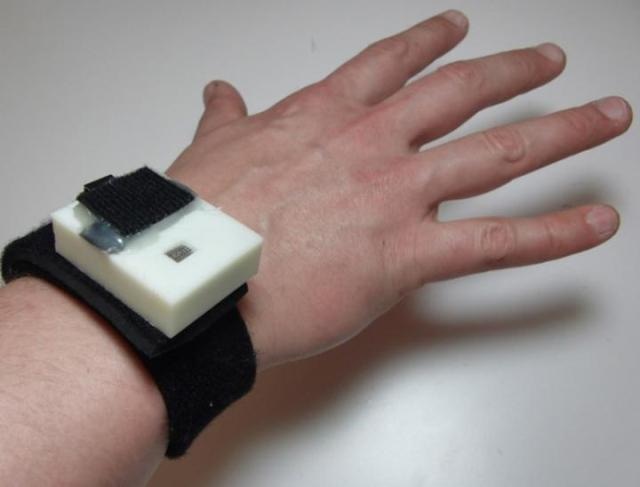Jun 3 2016
A team of researchers have created an integrated, wearable system that is capable of monitoring heart rate, user’s environment, and other physical characteristics with the objective of estimating and preventing asthma attacks. The researchers plan to start evaluating the system on a larger audience later in the year.
 This is an early prototype of the wristband used in the Health and Environmental Tracker (HET), an integrated, wearable system that monitors a user's environment, heart rate and other physical attributes with the goal of predicting and preventing asthma attacks. (Photo credit: James Dieffenderfer)
This is an early prototype of the wristband used in the Health and Environmental Tracker (HET), an integrated, wearable system that monitors a user's environment, heart rate and other physical attributes with the goal of predicting and preventing asthma attacks. (Photo credit: James Dieffenderfer)
The system, known as the Health and Environmental Tracker (HET), is made up of a number of new sensor devices and was created by researchers from the National Science Foundation’s Nanosystems Engineering Research Center for Advanced Self-Powered Systems of Integrated Sensors and Technologies (ASSIST) at North Carolina State University.
According to the Centers for Disease Control and Prevention, asthma impacts the lives of more than 24 million people in the US. At the moment, asthma patients depend upon inhalers to handle their symptoms, which can include frequently-debilitating asthma attacks.
“Our goal was to design a wearable system that could track the wellness of the subjects and in particular provide the infrastructure to predict asthma attacks, so that the users could take steps to prevent them by changing their activities or environment,” says Alper Bozkurt, the principal investigator of a paper illustrating the work and an assistant professor of electrical and computer engineering at NC State.
Preventing an attack could be as simple as going indoors or taking a break from an exercise routine.
James Dieffenderfer, lead author of the paper and a Ph.D. student in the joint biomedical engineering program at NC State and the University of North Carolina at Chapel Hill.
The HET system blends a number of new sensing devices, which are integrated into a patch and a wristband that sticks to the chest.
The patch consists of sensors that track heart rate, a patient’s movement, skin impedance, the amount of oxygen in the blood, and wheezing in the lungs.
The wristband is meant primarily for environmental factors – to monitor ozone in the air and volatile organic compounds, as well as ambient temperature and humidity. The wristband also consists of extra sensors to monitor heart rate, motion, and the quantity of oxygen in the blood.
The system also comprises a single non-wearable part: a spirometer, which patients use to breathe into many times a day to measure lung operation.
Right now, people with asthma are asked to use a peak flow meter to measure lung function on a day-to-day basis. That information is used to inform the dosage of prescription drugs used in their inhalers.
James Dieffenderfer
“For HET, we developed a customized self-powered spirometer, which collects more accurate information on lung function and feeds that data into the system,” Dieffenderfer adds.
Data from these sensors can be transmitted wirelessly to a computer. A custom software in the computer gathers and stores the data.
“The uniqueness of this work is not simply the integration of various sensors in wearable form factors,” says Veena Misra, co-author of the paper and a professor of electrical and computer engineering at NC State. “The impact here is that we have been able to demonstrate power consumption levels that are in the sub-milliwatt levels by using nano-enabled novel sensor technologies. Comparable, existing devices have power consumption levels in the hundreds of milliwatts.
“This ultra-low power consumption is important because it gives the devices a long battery life, and will make them compatible with the power generated by the body – which is not a lot,” says Misra, who is also the director of the ASSIST Center. “It enables a pathway to realize the ASSIST Center’s vision of wearable sensors powered by energy from the body in the near future.”
We have tested the system in the benchtop and on a limited number of human subjects for proof of concept demonstration and have confirmed that all of the sensors work, and that the system accurately compiles the data. This summer, we plan to begin testing HET in a controlled environment with subjects suffering from asthma and a control group, in order to identify which environmental and physiological variables are effective at predicting asthma attacks.
Veena Misra
“Once we have that data, the center can begin developing software that will track user data automatically and give users advance warning of asthma attacks,” says Bozkurt, who as testbed leader of the ASSIST Center is responsible for HET system integration. “And that software will allow users to synch the HET to their smartphones so that they can monitor their health on the go. After these tests are completed, and the prediction software created, we are hoping that a fully functional HET system will be available.”
The paper, “Low Power Wearable Systems for Continuous Monitoring of Environment and Health for Chronic Respiratory Disease,” is published in the IEEE Journal of Biomedical and Health Informatics. The paper was co-authored by Henry Goodell and Brinnae Bent of the joint biomedical engineering program; Steven Mills, Michael McKnight, Shanshan Yao, Feiyan Lin, Eric Beppler, Bongmook Lee, Veena Misra, Omer Oralkan, Jason Strohmaier, John Muth, and Alper Bozkurt of NC State; and Dr. David Peden of UNC-CH.
The research was performed via the ASSIST Center at NC State, under NSF grant number EEC-1160483. The research was also supported by the National Institute of Environmental Health Sciences, under grant number R01ES023349, and by the Environmental Protection Agency, under cooperative agreement number CR 83578501.